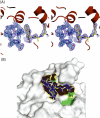Crystal structure of the Fic (Filamentation induced by cAMP) family protein SO4266 (gi|24375750) from Shewanella oneidensis MR-1 at 1.6 A resolution
- PMID: 19127588
- PMCID: PMC2674511
- DOI: 10.1002/prot.22338
Crystal structure of the Fic (Filamentation induced by cAMP) family protein SO4266 (gi|24375750) from Shewanella oneidensis MR-1 at 1.6 A resolution
Figures




Similar articles
-
The three-dimensional crystal structure of the PrpF protein of Shewanella oneidensis complexed with trans-aconitate: insights into its biological function.Protein Sci. 2007 Jul;16(7):1274-84. doi: 10.1110/ps.072801907. Epub 2007 Jun 13. Protein Sci. 2007. PMID: 17567742 Free PMC article.
-
Structures of the first representatives of Pfam family PF06938 (DUF1285) reveal a new fold with repeated structural motifs and possible involvement in signal transduction.Acta Crystallogr Sect F Struct Biol Cryst Commun. 2010 Oct 1;66(Pt 10):1218-25. doi: 10.1107/S1744309109050416. Epub 2010 Mar 5. Acta Crystallogr Sect F Struct Biol Cryst Commun. 2010. PMID: 20944214 Free PMC article.
-
Structural dissection of Shewanella oneidensis old yellow enzyme 4 bound to a Meisenheimer complex and (nitro)phenolic ligands.FEBS Lett. 2017 Oct;591(20):3391-3401. doi: 10.1002/1873-3468.12833. Epub 2017 Sep 15. FEBS Lett. 2017. PMID: 28869767
-
Adenylylation control by intra- or intermolecular active-site obstruction in Fic proteins.Nature. 2012 Jan 22;482(7383):107-10. doi: 10.1038/nature10729. Nature. 2012. PMID: 22266942
-
Structural insights into substrate recognition in proton-dependent oligopeptide transporters.EMBO Rep. 2013 Sep;14(9):804-10. doi: 10.1038/embor.2013.107. Epub 2013 Jul 19. EMBO Rep. 2013. PMID: 23867627 Free PMC article.
Cited by
-
Protein expression, characterization, crystallization and preliminary X-ray crystallographic analysis of a Fic protein from Clostridium difficile.Acta Crystallogr F Struct Biol Commun. 2014 Jun;70(Pt 6):827-31. doi: 10.1107/S2053230X1400987X. Epub 2014 May 25. Acta Crystallogr F Struct Biol Commun. 2014. PMID: 24915103 Free PMC article.
-
Acquisition through horizontal gene transfer of plasmid pSMA198 by Streptococcus macedonicus ACA-DC 198 points towards the dairy origin of the species.PLoS One. 2015 Jan 13;10(1):e0116337. doi: 10.1371/journal.pone.0116337. eCollection 2015. PLoS One. 2015. PMID: 25584532 Free PMC article.
-
Comparative analysis of Histophilus somni immunoglobulin-binding protein A (IbpA) with other fic domain-containing enzymes reveals differences in substrate and nucleotide specificities.J Biol Chem. 2011 Sep 16;286(37):32834-42. doi: 10.1074/jbc.M111.227603. Epub 2011 Jul 27. J Biol Chem. 2011. PMID: 21795713 Free PMC article.
-
The DNA-binding induced (de)AMPylation activity of a Coxiella burnetii Fic enzyme targets Histone H3.Commun Biol. 2023 Nov 6;6(1):1124. doi: 10.1038/s42003-023-05494-7. Commun Biol. 2023. PMID: 37932372 Free PMC article.
-
Structure and function of Fic proteins.Nat Rev Microbiol. 2015 Oct;13(10):631-40. doi: 10.1038/nrmicro3520. Epub 2015 Aug 24. Nat Rev Microbiol. 2015. PMID: 26299785 Review.
References
-
- Komano T, Utsumi R, Kawamukai M. Functional analysis of the fic gene involved in regulation of cell division. Res Microbiol. 1991;142:269–277. - PubMed
-
- Li W, Godzik A. Cd-hit: a fast program for clustering and comparing large sets of protein or nucleotide sequences. Bioinformatics. 2006;22:1658–1659. - PubMed
-
- Clark HF, Gurney AL, Abaya E, Baker K, Baldwin D, Brush J, Chen J, Chow B, Chui C, Crowley C, Currell B, Deuel B, Dowd P, Eaton D, Foster J, Grimaldi C, Gu Q, Hass PE, Heldens S, Huang A, Kim HS, Klimowski L, Jin Y, Johnson S, Lee J, Lewis L, Liao D, Mark M, Robbie E, Sanchez C, Schoenfeld J, Seshagiri S, Simmons L, Singh J, Smith V, Stinson J, Vagts A, Vandlen R, Watanabe C, Wieand D, Woods K, Xie MH, Yansura D, Yi S, Yu G, Yuan J, Zhang M, Zhang Z, Goddard A, Wood WI, Godowski P, Gray A. The secreted protein discovery initiative (SPDI), a large-scale effort to identify novel human secreted and transmembrane proteins: a bioinformatics assessment. Genome Res. 2003;13:2265–2270. - PMC - PubMed
Publication types
MeSH terms
Substances
Grants and funding
LinkOut - more resources
Full Text Sources
Molecular Biology Databases

